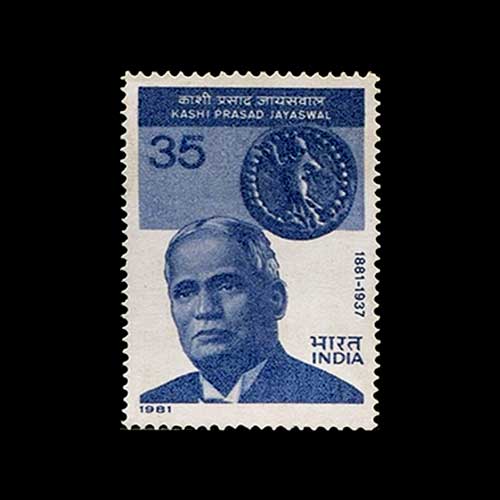Fascinating Archaeological Facts on Postage Stamps - 35
2025-05-19 Mon
Kashi Prasad Jayaswal, popularly known as KP Jayaswal, is a distinguished figure in the field of Indian historiography. His seminal works, Hindu Polity (1918) and History of India, 150 A.D. to 350 A.D. (1933), are widely regarded as foundational texts in ancient Indian historical literature. In his research, Jayaswal effectively emphasized the presence of #Democratic principles and institutions in ancient India, integrating the concept of collective decision-making into his analysis. His examination of gana rajyas, or republics, illuminates their significant contributions to the early development of #Republican governance.Beyond his contributions to historical scholarship, Jayaswal was also a recognized authority in numismatics. His notable discoveries of various coins from the #Maurya and Gupta periods led to his distinction as the first Indian invited to present at the esteemed Royal Asiatic Society of London in 1931.
In recognition of his impactful legacy, India Post issued a commemorative stamp on November 27, 1981, celebrating his birth centenary. This stamp features his portrait alongside the reverse side of a Yaudheya coin, highlighting his contributions to the understanding of ancient Indian numismatics.
The Yaudheyas were a prominent ancient Indian republican Tribe, notable for their martial prowess. They are mentioned in #Panini's Ashtadhyayi and #Ganapatha. Later sources identify them as the Ayudha jivi sangha, a community engaged in the profession of arms.
Historians documenting Alexander’s campaigns noted a significant republican territory along the beas River, describing it as "exceedingly fertile" with inhabitants recognized for their agricultural skills and valor in war, all governed under an effective internal administrative system. Jayaswal identified this territory with the Yaudheya Republic, which thrived between the 5th century BCE and the 4th century CE.
The Yaudheyas did defeated the #Kushans. Specifically, the Yaudheyas, along with other Janapadas in the Sutlej region, are credited with dealing a significant blow to the Kushans around 180 CE, effectively removing their presence from the Eastern Punjab. This victory is supported by both historical accounts and numismatic evidence, with Yaudheyan coins even commemorating the event with a shift from the Kushan #Kharosthi script to the Brahmi script.
John Allan, a noted British numismatist, classified the Yaudheya coins into six distinct categories. Allan's class 6 represents the most extensive collection, with these coins discovered across a broad geographical area, including present-day Punjab (specifically south of the Sutlej River), Haryana , northern Rajasthan , and southeastern Pakistan.
The coin depicted on the stamp, as Prof Devendra Handa mentioned in his book Tribal Coins of India are based on Kushana Module, typically feature Karttikeya standing with a spear, often accompanied by a peacock or a cock. The Brahmi inscription on these coins reads "Yaudheya ganasya jaya," occasionally followed by "dvi" or "tri." The reverse side prominently displays #Devasena, the spouse of Karttikeya, standing slightly turned to her left. These coins were produced through both die-striking and casting methods and were likely issued during the 3rd to 4th centuries CE. A substantial number of coin molds of this particular type have been discovered at #Sunet in #ludhiana , Punjab, further underscoring their historical significance.
Latest News
-
Ghiyath Shah as Sultan
2025-10-17 FriAfter ascending the throne of the Malwa Sultanate, Ghiyath Shah issued circular coins early in his r...
-
Malwa Sultan Ghiyath Shah Square Gold Tanka
2025-10-16 ThuMalwa Sultan Ghiyath Shah issued square gold tankas in three weight standards: Double Tanka (21.9g),...
-
Malwa Sultan Ghiyath Shah's Billon Tanka as Heir Apparent
2025-10-14 TueIn Billon, Ghiyath Shah issued coins under two weight standards. Billon Tanka of 96 rati (10.7-11g),...
-
Antiochos I Soter Silver Tetradrachm, weighing 16.87 grams, sold for INR 22,000.
2025-10-07 TueAntiochos I, the Greek king of the Seleucid Empire, was of mixed heritage, being half-Iranian and ha...
-
Ghiyath Shah as Heir Apparent
2025-09-25 ThuGhiyath Shah was the ruler of the Malwa Sultanate, reigning from 1456 to 1500. From 1456 to 1469, he...

